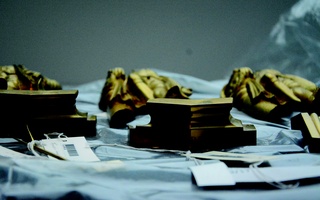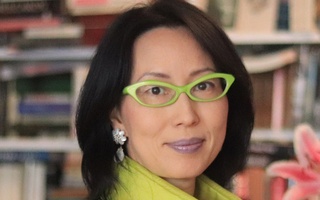{shortcode-8738e611ffa7006fc227f0073b20ed4dbe2f4f09} UPDATED: November 25, 2015, at 11:29 p.m.
During its renovation, the Harvard Art Museums experienced a simultaneous physical and conceptual shift. In the past year, museum coordinators, directors, and students have implemented a variety of programming focused on spontaneous connection and interdisciplinary inspiration. From the student board’s new input on the institution, to the public tours curated by individual student guides, to the plethora of programming for scholars, curators, and conservators, the institution is booming. More than 4,000 visitors have utilized the lecture halls, the three study rooms, the two seminar rooms, and other new spaces in the first year of operation alone. The institution’s caretakers consider the museums to be, more than anything, one huge classroom.
PORTRAIT OF THE ARTIST AS A UNIVERSITY STUDENT
Jessica Martinez, head of the Museums’ division of academic and public programs, emphasizes first and foremost that students are the priority in these immersive experiences. During events, the first few lecture hall rows are regularly reserved for students, as are a few seats in the regular 15-person seminars. But one of the largest challenges the program directors faced was raising awareness of the Museums’ events among the student body. Officially, the museums were closed between 2008 and 2014, with the exception of the the Arthur M. Sackler Museum, which remained open through 2013. An entire generation of Harvard students arrived and left during that period of time. “A lot of what we’re doing has been generated by students themselves,” says Erin Northington, the museum’s manager of student engagement programs.
Rob J. Hopkirk ’18, a current student board member, first connected with the Museums during his time on the 2014-2015 First Year Social Committee, which planned a freshman-only “After Hours at the Harvard Art Museums” event in April 2015. According to Hopkirk, that collaboration grew out of a conversation the group initiated with the museum staff about freshman programming. The directors were wholly enthusiastic, and the event was billed as an introduction to the artwork, one piece of which had never before been seen. The idea was to help freshmen realize the enormous changes that had been going on before their arrival on campus. “It’s mind-boggling how you can just step across the street from the Yard, enter the lobby, turn the corner, and you’re facing a Picasso,” Hopkirk says. “That immediacy of the space is important.”
The student guide program, in which 24 undergraduates from 14 different concentrations craft their own unique public tours, has been updated since the renovation. The program is unique in that the staff does not force the guides to follow set routes; student guides focus on the objects they find most engaging and build dialogue based on their own artistic interests. David Odo, the director of student programs and research curator for University Collections Initiatives, works closely with the guides. Before the renovation, a majority of the guides were History of Art and Architecture concentrators, but Odo finds the greater spread of disciplines creates a more dynamic conversation. “It’s not that we expect them to be pre-trained in art history,” Odo says. “What is most important is that they have a real passion for learning about our collections, and having really interesting conversations with fellow students, with member of the general public, whoever comes on our tours.”
GETTING UNDERGRADUATES ON BOARD
The Harvard Art Museums’ student board arose in fall 2014 in response to a perceived lack of permanent connections with the undergraduate community. Led by Erin Northington, the 16 students work to maintain a vibrant link between the Museums’ programming and the student body. “I consider the board my mentors,” Northington says. “I think that we’re a team. I learn so much from them.” The board’s main tasks include meeting to provide input to museum operations, acting as representatives within their respective Houses and concentrations, and participating in on-campus events. Northington stresses that she wants students to be involved in whatever capacity they wish. “My hope is that students feel responsible for this place,” she says. “And they feel responsible in whatever way makes sense for who they are and what they’re doing here.”
In comparison with last year’s monthly meetings, the board now meets bimonthly to brainstorm student publicity, generate ideas for new programs, and set members up with events where they would like to volunteer. Northington has expanded publicity from the Museums’ still growing 1,000-member email list to other avenues based on the ideas and resources of the student board. For example, she recently disseminated specially made bookmarks to student board members to spread throughout their Houses. Additionally, “Corita Night,” held during community dinner on Oct. 15, linked the Museums with Harvard University Dining Services chefs to create meatball dishes inspired by Corita Kent’s screenprinted pop art. “A lot of museum education groups plan multiple years out,” Martinez says. “We do the same, but we want to be a bit more dynamic in what we offer so we can be relevant on this campus. So we want to respond to the conversations that are happening.”
Beyond showcasing exhibits, student board members serve as “satellite” representatives of the museum staff in the undergraduate Houses. Board members are aware of the full range of opportunities and events within the institution and thus can act as ambassadors. “It’s like having a staff member living residentially in the Houses,” Hopkirk says. “It’s a very big institution, and we don’t want it to become faceless. We can be the faces in the Houses.”
For the board members, the opportunity to work closely with the institution has granted them the chance to interact with the museum on a more intimate level. In November 2014, member Bobby T. Fitzpatrick ’16 witnessed German multimedia artist Rebecca Horn publically activate the installation “Flying Books under Black Rain Painting (2014).” “Without the Art Museums, I don’t know where else I would’ve seen that: a professional artist creating art. And every time I walk past it, I think: wow. I saw that happen.”
PROGRAMMING IS AN ART FORM
A sense of openness permeates the teaching spaces on the fourth and fifth floors of the Harvard Art Museums. Glass walls in the Straus Center for Conservation and Technical Studies and the Art Study Center allow students and public patrons to see the activity of conservators and researchers. What is normally kept hidden and private is out in the open, as if the very art of conservation is now artwork. The museums’ programming as a whole embodies this approach. “We want our events to be a bit more organic,” Jessica Martinez says. “We’re trying to understand what the life of a student is here so that the museum spaces can be part of that regular schedule.”
In terms of curation, many of the current exhibitions within-gallery spaces stem from faculty conversations. The museum’s third floor currently features “Corita Kent and the Language of Pop,” an exhibit that originated in a Pop art course last semester with professor Jennifer L. Roberts. One initiative has linked a number of university departments through a three-part series titled "What's Light Got To Do With It?". Inspired by the UN designation of 2015 as the International Year of Light, the series will connect faculty members together with the public. Specifically for undergraduate courses, the University Teaching Gallery and University Study Gallery are designed to feature both semesterly and weekly rotations of pieces related to various courses in both the undergraduate and graduate curricula.
Francesca G. Bewer, research curator for conservation and technical studies, emphasized the importance of digital spaces in bringing these interdisciplinary programs to the academic and public communities. “The digital space is amazing, what it affords [these speakers] to do, to visualize, to see their amazing images on a large scale,” she says of the Lightbox Gallery on the fifth floor. One half of the Lightbox Gallery consists of a 12’ by 6.75’ wall installation of LCD HD screens. On the opposite wall, a double-layered fabric screen serves as a canvas for two high-resolution projectors. “That kind of display is pretty rare.” The Lightbox Gallery was heavily featured during the Cambridge Science Festival last spring, when 10 speakers presented their science projects using the space’s digital projection.
Read more in Arts
Hear Me Out: Adele, 'Hello'Recommended Articles
-
Search for Museum Director Nears EndThe search for a new director for the Harvard University Art Museums is nearing an end, over a year after
-
 New Curators Join the Renovated Harvard Art Museums
New Curators Join the Renovated Harvard Art Museums -
Harvard Art Museums Introduce New Director at Student Late NightThe Harvard Art Museums stayed open late on Thursday to introduce their new director to students.
-
 Preview: The Philosophy Chamber at the Harvard Art Museums
Preview: The Philosophy Chamber at the Harvard Art Museums -
 Soyoung Lee Named Chief Curator of the Harvard Art Museums
Soyoung Lee Named Chief Curator of the Harvard Art Museums













